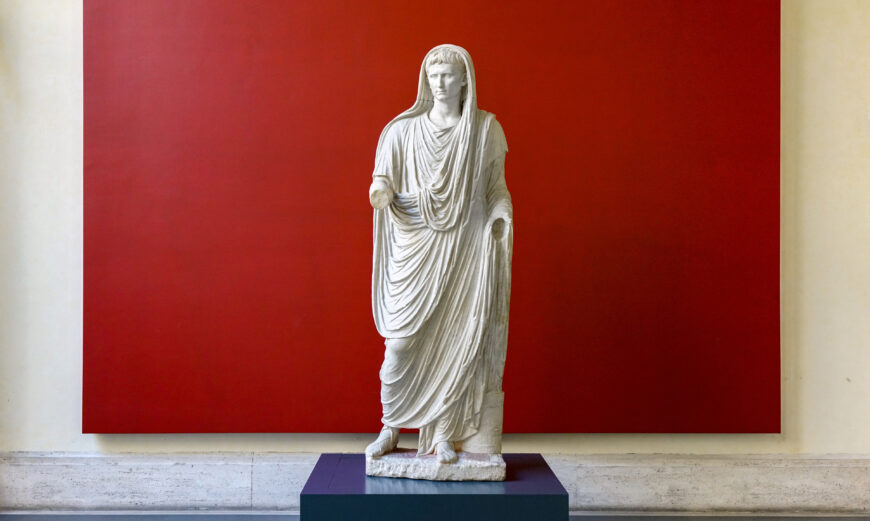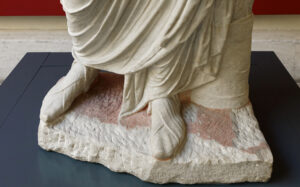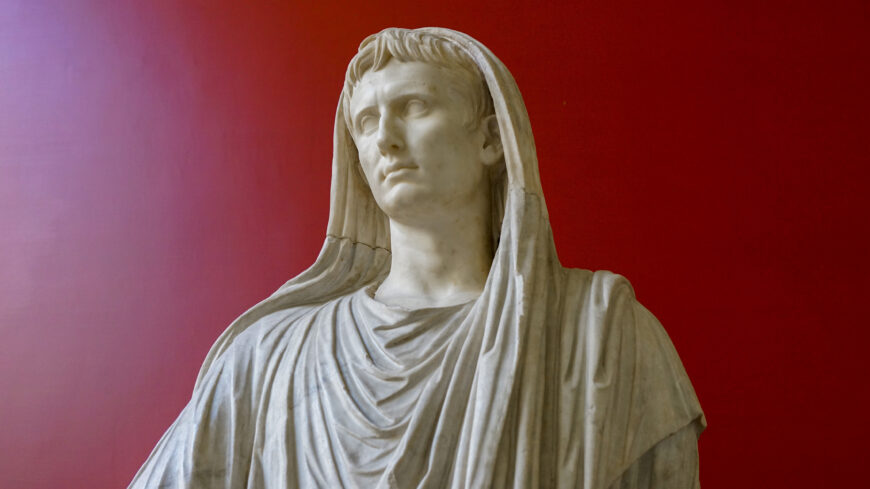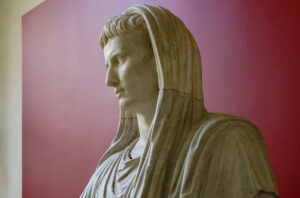
Augustus as Pontifex Maximus, after 12 B.C.E., marble, 208 cm high, found in the Via Labicana, Rome (Palazzo Massimo Alle Terme, Rome; photo: Steven Zucker, CC BY-NC-SA 2.0)
Devout and serene, this portrait of Augustus showcases one of the numerous positions held by the first emperor of ancient Rome—as chief high priest (in Latin: Pontifex Maximus).
This heroically scaled marble statue of Augustus was discovered in Rome in the early 20th century. It depicts the emperor as a togatus (a Roman citizen wearing a toga). The voluminous drapery appears to wrap around his body numerous times, including over his head, which helps denote him as a priest. This is known as capite velato, or veiled head. Priests pulled their togas over their heads as a symbol of piety and deference when performing rituals, especially sacrifices to the gods.
The head of Roman religion
The Pontifex Maximus (chief high priest) served as the head of the ancient Roman state religion. Starting as early as the Roman regal period, when Rome was ruled by kings (753–509 B.C.E.), the Pontifex Maximus ruled the Collegium Pontificum (College of Pontiffs), the most important priests of the Roman state religion and often high-ranking Roman politicians. After the end of the Roman regal period and throughout the Roman Republic (509–27 B.C.E), the members of the Collegium and the Pontifex Maximus himself took over some of the religious responsibilities previously held by the king.
In 27 B.C.E., Gaius Octavius, the great-nephew of Julius Caesar, was granted the title of Augustus (the greatest or most venerable) and primus inter pares (the first among equals) by the Roman Senate, effectively ending the Roman Republic and ushering in the start of the Roman Empire. Slowly, he and his most loyal friends and supporters acquired additional titles until all positions of power fell to Augustus or those who worked with him. When the last remaining Republican-era Pontifex Maximus (Marcus Aemilius Lepidus), died in 12 B.C.E., Augustus was granted the title, one of the last puzzle pieces to the completion of his imperial power. Not only was he the commander of the Roman armies and the political ruler of Rome, he now held leadership over the Roman religion as well.
Augustus as Pontifex Maximus

Shoes (detail), Augustus as Pontifex Maximus, after 12 B.C.E., marble, 208 cm high, found in the Via Labicana, Rome (Palazzo Massimo Alle Terme, Rome; photo: Steven Zucker, CC BY-NC-SA 2.0)
In the sculpture, Augustus’ body is mostly concealed beneath the diagonal folds of drapery except for his right leg below his knee, the shape of which is visible through the taut drapery. From underneath his drapery, his shoes, known as calcei patricii or Patrician shoes as they were worn by the Roman elites, are visible. It is likely, based on the position of his right arm, that he once held a patera, a shallow bowl used for offering libations to the gods.
This sculpture displays Augustus’ piety, known in ancient Rome as pietas. Pietas describes the profound respect and dutifulness required to be given both to the gods and to kin, which also informed Roman morals, virtues, and ethics, and required devotion to the Roman state religion. Augustus believed strongly in these traditional Roman values and was often represented in art as participating in religious rituals. Another example of this is the ritual procession on the Ara Pacis Augustae, dedicated in 9 B.C.E., which was erected by the Senate in honor of Augustus.
A new golden age
Just as in the portrait of Augustus as Imperator, Augustus as Pontifex Maximus is depicted as a youthful and idealized figure with a short-cropped hairstyle and flawless skin. Despite being at least 50 years old when this portrait was created, images of Augustus always depicted him with a sense of youthful agelessness. This was deliberate visual propaganda created to portray him in the guise of an idealized, classical Greek sculpture. In this way, Augustus connects his rule and the grandeur of the fledgling Roman empire with the golden age of its classical predecessor, Greece.

Face (detail), Augustus as Pontifex Maximus, after 12 B.C.E., marble, 208 cm high, found in the Via Labicana, Rome (Palazzo Massimo Alle Terme, Rome; photo: Steven Zucker, CC BY-NC-SA 2.0)
His face, which is turned towards his right, betrays no hint of his personality. As is typical of Augustan portraiture, he is neutral and expressionless. Though he was now the most powerful man in Rome, he was always portrayed subtly to help ensure the stability of the empire and support of the Senate. The empire was new and not entirely legal, so the choice to portray himself as humble, moral, and devout was deliberate.
It is no surprise, of course, that the sculpture also stands in contrapposto, a naturalistic pose where weight is shifted onto one leg, in this case the left. This, too, derives from the sculptural styles of classical Greece and is found in some of the most famous works of that time, such as the Doryphoros.
A sculpture in two parts

Face (detail), Augustus as Pontifex Maximus, after 12 B.C.E., marble, 208 cm high, found in the Via Labicana, Rome (Palazzo Massimo Alle Terme, Rome; photo: Steven Zucker, CC BY-NC-SA 2.0)
The sculpture was created in two different pieces; in fact, two different marbles! The body of the sculpture was created in Luna marble (known today as Carrara) likely by a Roman artist as it came from a quarry in northern Italy newly opened by Augustus. It was common in ancient Rome to purchase a “stock” or standard sculptured body and add a portrait head later which could be personalized and inserted into the sculpture. That is the case with this work. The portrait head was created using Greek Pentelic marble, which suggests the portrait head was created by a Greek artist (who the Romans considered to be the finest sculptors).
Today, when looking closely at the sculpture, it is easy to see the line across the hood of the toga which divides the portrait head from the body as well as see where the neck has been inserted into the lower portion of the sculpture. This may have been less noticeable in antiquity, particularly since this sculpture would once have been painted with polychrome pigments, which once concealed the differences between the Luna and Pentelic marbles. Where today we see cold marble, the Romans would have seen a realistic, though highly idealized, life-like portrait.
A testament to Augustan propaganda, the sculpture of Augustus as Pontifex Maximus shows a dutiful man ushering in a new golden age for Rome. He remained Pontifex Maximus until his death after which time the succeeding emperors continued to hold the position until well into the 4th century C.E.
Additional resources
The Julio-Claudian Dynasty on The Metropolitan Museum of Art’s Timeline of Art History.
Karl Galinsky, Augustan Culture: An Interpretive Introduction (Princeton: Princeton University Press, 1996).
D. E. E. Kleiner, Roman Sculpture (New Haven: Yale University Press, 1994).
John Pollini, From Republic to Empire: Rhetoric, Religion, and Power in the Visual Culture of Ancient Rome (Norman: University of Oklahoma Press, 2012).
Paul Zanker, The Power of Images in the Age of Augustus, trans. Alan Shapiro (Ann Arbor: University of Michigan Press, 1990).
Smarthistory images for teaching and learning:
[flickr_tags user_id=”82032880@N00″ tags=”AugLab,”]

